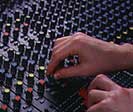| Author
|
Bass space
|
fuzzikitten
Annunaki

Started Topics :
40
Posts :
603
Posted : Jul 25, 2005 14:51
|
Discovered something this weekend that I thought I'd share.
I was reworking the kick and bass in my latest tune when I leaned way back in my chair and, suddenly, could hear the really *low* frequencies that I'd never been able to hear before.
I don't know if it is because I wasn't in the stereo field of my monitors, or simply because I was too close. All I know is that if I sat a good 5 feet back from my monitors (farther than I could reach my desk) I could suddenly hear my low'n'dirty frequencies - hallelujah! Fortunately I have a wireless mouse, so I can sit way back and tweak the settings whilst hearing the bass.
Also I've found that for mixing the bass I need my monitors *loud*, way louder than I normally mix at. I keep it at this volume only for brief periods (a few minutes to tweak and EQ) and then bring it back down to comfortable volumes.
Happy tweaking.  |

|
|
tokolosh
IsraTrance Junior Member

Started Topics :
14
Posts :
76
Posted : Jul 25, 2005 15:36
|
Hi fuzzikitten
it really depends on the size and shape of your room and the frequency you are listening too .This is caused by standing waves in your room .The best place for you to sit would be 3/4 into your room so you will hopefully avoid the dip point of the bass frequency phase .Try to put your speakers in parallel to the width of the room so they are pointed to the length of the room .This should give you a better bass response .There are programs to measure this called ETF or acoustic-X but ETF is the better one (don’t worry about the mic any mic can be calibrated or give you a close result for the low frequencies only )
good luck
|

|
|
fuzzikitten
Annunaki

Started Topics :
40
Posts :
603
Posted : Jul 25, 2005 15:47
|
Quote:
|
On 2005-07-25 15:36, tokolosh wrote:
Try to put your speakers in parallel to the width of the room so they are pointed to the length of the room .
|
|
*sigh* I only wish this were possible. My 'studio' is my girlfriend's walk-in closet, and it's about 6'X5' big. I have 8" of insulation on all the walls though, so while it's tiny as heck at least it's quiet.
My speakers *are* facing the length of the closet though, so maybe I'm already doing this?
In November we move in to a townhouse, so I'll get a proper studio in the basement (hurray!). I'll be sure to put them at the length of the room.
Thanks for the thoughts!
-Alex |

|
|
tokolosh
IsraTrance Junior Member

Started Topics :
14
Posts :
76
Posted : Jul 25, 2005 17:24
|
hehe its good to hear you'll be getting out of the closet.  |

|
|
shachar
Basic

Started Topics :
13
Posts :
402
Posted : Jul 26, 2005 11:45
|
well, mixing should be done louder than you usuallly work.
|

|
|
Psylopath
IsraTrance Junior Member

Started Topics :
13
Posts :
87
Posted : Jul 27, 2005 12:34
|
what else is important in order to get the best sound in my room?
Im asking, because I'll move to my girlfriend during the next month, and there I'll have an own room just for making music.
whats the best distance between 2 nearfield monitors (adam p11)?
|

|
|
Freeflow
IsraTrance Full Member

Started Topics :
60
Posts :
3709
Posted : Jul 27, 2005 17:50
|
Psylopath - i believe for nearfield monitoring, 1 meter for each side.. but read this,
"Near field has another meaning which is completely glossed over by the manufacturers. At the typical crossover frequencies and listening distances of most ?near field? monitors the distances between the tweeter, midbass and listener are all similar. This is actually the midfield (in physics speak).
So what, you ask? Well, the radiation pattern in this midfield region is very complex and the response changes dramatically with small changes in position of the listener. If a manufacturer claims they have designed their speakers with a flat response in the ?near field?, they have done it for a very specific distance and angle relative to the monitors. Any deviation from this specific position which they placed their test microphone will cause significant response anomalies, especially in the crossover band.
This argument is mainly aimed at the separate tweeter/midbass design of the majority of monitors. There are some exceptions. Dual concentric drivers like those used by Tannoy should not suffer from this problem as long as your ears are directly on axis. Planar magnetic, electrostatic, or ribbon speakers, where the dimensions of the source are large relative to the listening distance, might also offer a very good near field solution with little positional dependence. These are, however, large, expensive and not terribly practical.
Just a thought. " "
try finding the sweetspot in the(your) triangle my friend  and ask the manufacturers of your speakers how they are calibrated and should be listend to...maybe. and ask the manufacturers of your speakers how they are calibrated and should be listend to...maybe.
its such a science how acoustics works, its more then just listening position... i still dont have much of a clue... hehe |

|
|
Psylopath
IsraTrance Junior Member

Started Topics :
13
Posts :
87
Posted : Jul 28, 2005 12:49
|
thx 4 the answer.
i think asking the manufacturer is really a good idea.
what do I have to take care as far as my room is concerned.
does anyone know good tutorials or other infos in the web about making good room acoustics?
lg psylo |

|
|